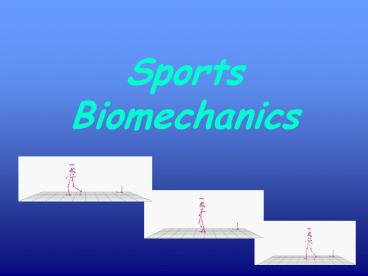Sports Biomechanics - PowerPoint PPT Presentation
1 / 30
Title:
Sports Biomechanics
Description:
Biomechanics in Sports Role of biomechanics in sports understanding sporting performance examine internal and external forces acting on the body and the effects ... – PowerPoint PPT presentation
Number of Views:2220
Avg rating:3.0/5.0
Title: Sports Biomechanics
1
Sports Biomechanics
2
Biomechanics in Sports
One of the ergogenic aids in sports
3
Role of biomechanics in sports
- understanding sporting performance
- examine internal and external forces acting on
the body and the effects - examine sports equipment, sporting surface etc.
- understanding causes of injury
4
Whats the information for?
- Improve sport performance / technique
- Prevention of sport injuries
- Design of sport equipment
- Clinical analysis of movement pathologies
- Design of prosthesis
5
Spectrum of sports biomechanics
Biomechanics
Kinetics
Kinematics
Electromyography
Static
. Force . Torque
. Position .Velocity . Acceleration
. Muscle recruitment . Timing . Firing rate
6
Effects of kinematics in sports
- Better understanding of human movement during
sports - Optimal body positions and actions for
efficient, effective motion
- Reach desired outcome of individual sport -
Injury prevention
7
Kinematics analysis
- Visual
- Goniometer
- Photo
- video
8
Kinematics studies in sports
- Muybridge Marey (1830-1904)
Adapted from Biolocomotion a century of
research using moving pictures
9
Now
10
Kinematics studies in sports
- Lower Extremity Range of Motion in the
Recreational Sport Runner (Pink et al. 1994)
11
Model of systematic computerized kinematic
analysis
- identify major movement
- identify essential component and the desired
outcome - capturing of movement
- joint angles of interested are defined and
plotted as a function of time - angular velocity and acceleration profile can be
calculated
12
Kinematics analysis in sports
- nature of the activities high resolution
camera is required - measurements during competition interference
caused by sunlight
13
Kinetics
- is the measurement of
- forces and torque that cause or against the
motion
14
What for ?
- provide information about how the movement
is produced or how a position maintained
15
Kinetics in Sports
16
Force-plate
- Quantified via the deformation of transducer
elements
17
- Measurement of the three orthogonal components of
the net force, and the three components of the
net moments
(adapted from Crossley et al. 1998)
18
Ground reaction force (GRF) during landing from a
jump (adapted from Dufek 1991)
19
Manipulations to minimize PGRF
- Surface
- Shoe
- Techniques
20
Manipulations to minimize PGRF
- technique
- The pattern of footfall and the magnitudes of
the peak force were studied by Valiant and
Cavanagh in 1985 in ten basketball players. Eight
subjects landed with a toe-heel pattern, and two
with flatfoot. The peak force from toe-heel
landing was 4.1 BW, and flatfoot was 6.0BW.
21
Frictional force
- determines the relative ease or difficulty of
motion of 2 objects in contact - F R
22
Manipulation of frictional force
- to increase frictional force when stability is
needed - grip on the handle of the racquets
- to decrease frictional force when smoothness of
movement is required - dance studio waxed with Rosin
23
Static studies - stability
- Stability is the resistance to disruption of
equilibrium
24
Stability in Sports
- Does injury affects stability?
- What types of external support is able to improve
stability?
25
Electromyography
- Electromyography is the analysis of muscle
function via the measurement of the electrical
activity of muscles using surface electrodes or
indwelling electrodes.
26
EMG in Sports
- Its role is to
- identify the muscles that are active and
inactive - The timing or sequencing of the active muscles in
different postures and movements, in healthy and
injured athletes
27
Spectrum of sports biomechanics
Biomechanics
Kinetics
Kinematics
Electromyography
Static
. Force . Torque
. Position .Velocity . Acceleration
. Muscle recruitment . Timing . Firing rate
28
So what?
- Knows the sports
- Knows the athletes
- Knows the environments
29
Interventions for the desired outcomes/injury
prevention
- Conditioning
- Technique
- Playing surface
- Sports equipment
- Protective equipment
- Rehabilitation
30
(No Transcript)































